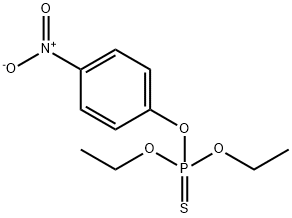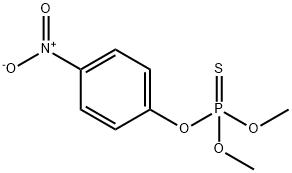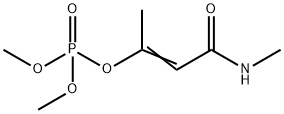M2266653
dNTPMixture , EACH2.5mm, filtering and high temperature dual sterilization
Synonym(s):
O,O-Diethyl O-(4-nitrophenyl) phosphorothioate;Ethylparathione;Parathion-ethyl;Parathion-ethyl solution
CAS NO.:
Empirical Formula: C10H14NO5PS
Molecular Weight: 291.26
MDL number: MFCD00036219
EINECS: 200-271-7
Update time: 2022-07-08
PRODUCT Properties
| Melting point: | 6.1°C |
| Boiling point: | 375°C |
| Density | 1.26 |
| vapor pressure | 0.470 at 20 °C, 0.942 at 25 °C, 1.84 at 30 °C, 3.53 at 35 °C, 6.62 at 40 °C, 12.18 at 45 °C (gassaturation method, Spencer et al., 1979) |
| refractive index | nD25 1.5370 |
| Flash point: | 120 °C |
| storage temp. | APPROX 4°C |
| solubility | 2,900 and 2,700 g/kg in petroleum ether and heptane, respectively (Williams, 1951) |
| form | liquid |
| color | Pale-yellow liquid |
| Water Solubility | Slightly soluble |
| Merck | 13,7105 |
| BRN | 8912188 |
| Henry's Law Constant | 8.56 at 25 °C (wetted-wall column, Fendinger and Glotfelty, 1990) |
| Exposure limits | NIOSH REL: TWA 0.05 mg/m3, IDLH 10 mg/m3; OSHA PEL: TWA
0.1 mg/m3. |
| Stability: | Hygroscopic, Moisture Sensitive |
| CAS DataBase Reference | 56-38-2(CAS DataBase Reference) |
| IARC | 2B (Vol. 30, Sup 7, 112) 2017 |
| NIST Chemistry Reference | Ethyl parathion (o,o-diethyl-o-p-nitrophenylthiophosphate)(56-38-2) |
| EPA Substance Registry System | Parathion (56-38-2) |
Description and Uses
After exposure to parathion ethyl, one case of a bullous contact dermatitis was reported.
Parathion is used to control sucking and chewing insects, mites and soil insects in a very wide range of crops.
Safety
| Symbol(GHS) |    GHS06,GHS08,GHS09 |
| Signal word | Danger |
| Hazard statements | H300+H310+H330-H372-H410 |
| Precautionary statements | P262-P273-P280-P302+P352+P310-P304+P340+P310-P314 |
| Hazard Codes | T+;N,N,T+,Xn,F |
| Risk Statements | 24-26/28-48/25-50/53-67-65-38-11 |
| Safety Statements | 28-36/37-45-60-61-62-16 |
| RIDADR | UN 3278 |
| OEB | D |
| OEL | TWA: 0.05 mg/m3 [skin] |
| WGK Germany | 3 |
| RTECS | TF4550000 |
| HazardClass | 6.1(a) |
| PackingGroup | I |
| HS Code | 29201100 |
| Hazardous Substances Data | 56-38-2(Hazardous Substances Data) |
| Toxicity | LD50 in female, male rats (mg/kg): 3.6, 13 orally; 6.8, 21 dermally (Gaines) |
| IDLA | 10 mg/m3 |



